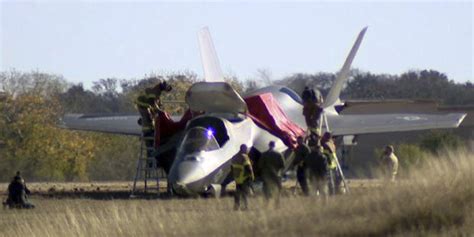
A U.S. Air Force F-35A Lightning II stealth fighter, while flying a routine training mission over Texas, successfully transmitted critical operational data across 5,000 miles to a command center in Denmark, showcasing the advanced communication and data-sharing capabilities of the fifth-generation aircraft. The demonstration highlighted the F-35’s role as a vital asset in international allied operations and its ability to seamlessly integrate with allied defense networks.
The data transmission, conducted as part of a broader exercise, underscores the F-35’s sophisticated sensor fusion and communication architecture, allowing for real-time information sharing between the aircraft and remote command centers, irrespective of geographical distance. This capability is particularly significant for coalition operations where interoperability and immediate access to battlefield intelligence are crucial.
“This successful data transfer demonstrates the F-35’s ability to act as a critical node in a global information network,” said a U.S. Air Force spokesperson. “It highlights the aircraft’s role in enhancing situational awareness and decision-making for both U.S. and allied forces.”
The specific type of data transmitted remains classified, but it is understood to include a combination of sensor data, tactical information, and aircraft status updates. The transmission was secured using advanced encryption protocols to protect against interception and maintain data integrity.
The exercise also served to validate the interoperability of U.S. and Danish defense systems, confirming the seamless integration of the F-35 into the Royal Danish Air Force’s operational framework. Denmark has committed to acquiring 27 F-35A aircraft, with the first delivery expected in 2024.
This demonstration of long-range data transmission is just one facet of the F-35’s advanced capabilities. Its stealth characteristics, sensor suite, and networking capabilities combine to create a formidable force multiplier on the modern battlefield. The aircraft is designed to operate in contested environments, providing unparalleled situational awareness and strike capabilities.
Technological Capabilities and Strategic Implications
The F-35’s ability to transmit data across vast distances is facilitated by its advanced communication systems, including the Multifunctional Advanced Data Link (MADL). MADL is a secure, low probability of intercept/low probability of detection (LPI/LPD) communication link specifically designed for fifth-generation fighter aircraft. It allows F-35s to exchange information with each other and with ground-based command centers in a secure and covert manner.
The successful data transmission to Denmark highlights the F-35’s potential to act as an airborne early warning and control (AEW&C) platform, providing real-time intelligence and targeting data to allied forces. This capability is particularly valuable in scenarios where traditional AEW&C assets are unavailable or vulnerable.
Furthermore, the F-35’s sensor fusion capabilities allow it to gather and process vast amounts of data from its onboard sensors, including radar, electronic warfare systems, and electro-optical/infrared sensors. This data is then integrated into a single, coherent picture of the battlespace, which can be shared with other F-35s, allied aircraft, and ground-based command centers.
The strategic implications of the F-35’s advanced communication and data-sharing capabilities are significant. The aircraft can enhance situational awareness, improve decision-making, and increase the effectiveness of coalition operations. It also allows for greater flexibility and responsiveness in dynamic and unpredictable environments.
Interoperability and Allied Integration
The F-35 is designed to be interoperable with a wide range of allied defense systems. This interoperability is crucial for ensuring seamless integration of the F-35 into coalition operations. The aircraft is equipped with a variety of communication protocols and data formats that allow it to exchange information with allied aircraft, ships, and ground-based systems.
The data transmission to Denmark is a testament to the F-35’s interoperability and its ability to seamlessly integrate with allied defense networks. This integration is facilitated by the Joint Strike Fighter program, which includes participation from several international partners. These partners have contributed to the development and production of the F-35, and they are actively involved in its operational deployment and support.
The F-35’s interoperability also extends to its logistics and maintenance support. The aircraft is supported by a global network of maintenance facilities and logistics hubs, which are designed to ensure that the F-35 is always ready for deployment. This global support network is essential for maintaining the F-35’s operational readiness and ensuring its long-term viability.
Denmark’s Acquisition of the F-35
Denmark’s decision to acquire the F-35A underscores the aircraft’s importance to the country’s future defense capabilities. The F-35 will replace Denmark’s aging F-16 fighter jets and will provide the Royal Danish Air Force with a significant increase in combat capabilities.
The Danish F-35s will be used for a variety of missions, including air defense, ground attack, and reconnaissance. They will also be used to support international coalition operations. Denmark is committed to working closely with its allies to ensure that the F-35 is effectively integrated into NATO’s defense posture.
The acquisition of the F-35 is a significant investment for Denmark, but it is seen as essential for maintaining the country’s security and its ability to contribute to international security efforts. The F-35 will provide Denmark with a state-of-the-art fighter jet that is capable of meeting the challenges of the 21st century.
Security Considerations and Data Protection
The transmission of sensitive data over long distances raises important security considerations. The F-35 is equipped with a variety of security measures to protect against data interception and cyberattacks. These measures include advanced encryption protocols, secure communication links, and robust cybersecurity defenses.
The data transmitted to Denmark was secured using these advanced security measures. The U.S. Air Force and the Royal Danish Air Force worked closely together to ensure that the data was protected throughout the transmission process. They also conducted regular security audits to identify and address any potential vulnerabilities.
The F-35’s cybersecurity defenses are constantly being updated to keep pace with the evolving threat landscape. The aircraft is equipped with a sophisticated suite of cybersecurity tools that are designed to detect and respond to cyberattacks in real-time. The U.S. Air Force and its allies are committed to maintaining the F-35’s cybersecurity posture and ensuring that the aircraft remains secure against cyber threats.
Future Developments and Enhancements
The F-35 is a constantly evolving platform. The U.S. Air Force and its allies are continuously working to develop and enhance the aircraft’s capabilities. Future developments include upgrades to the aircraft’s sensor suite, communication systems, and weapons.
One area of focus is on improving the F-35’s artificial intelligence (AI) capabilities. AI can be used to automate many of the tasks that are currently performed by pilots, such as target identification and threat assessment. This can free up pilots to focus on more complex tasks and improve their overall situational awareness.
Another area of focus is on developing new weapons for the F-35. The aircraft is currently armed with a variety of air-to-air and air-to-ground weapons, but new weapons are being developed to enhance its capabilities against a wider range of targets. These new weapons include hypersonic missiles, directed energy weapons, and unmanned aerial vehicles (UAVs).
The F-35 is expected to remain in service for several decades to come. The U.S. Air Force and its allies are committed to investing in the aircraft and ensuring that it remains a state-of-the-art fighter jet for the foreseeable future.
The Broader Context of Global Military Modernization
The F-35 program is a key component of a broader trend toward military modernization around the world. Many countries are investing in new technologies and capabilities to maintain their military advantage and address emerging threats. This modernization effort includes the development of new fighter jets, warships, tanks, and other advanced weapons systems.
The F-35 is one of the most advanced and capable fighter jets in the world. Its stealth characteristics, sensor suite, and networking capabilities make it a formidable force multiplier on the modern battlefield. The aircraft is being acquired by several countries around the world, and it is expected to play a major role in shaping the future of air warfare.
The F-35 program has also had a significant impact on the global defense industry. The program has generated billions of dollars in revenue for defense contractors around the world, and it has created thousands of jobs. The program has also fostered innovation and technological advancements in the defense industry.
Conclusion
The successful data transmission from an F-35 in Texas to Denmark is a powerful demonstration of the aircraft’s advanced capabilities and its importance to international security. The F-35’s ability to share information in real-time with allied forces, regardless of distance, significantly enhances situational awareness and decision-making. As Denmark prepares to integrate the F-35 into its air force, this exercise underscores the potential for seamless interoperability and collaboration within NATO. The F-35’s continuous evolution and integration of cutting-edge technologies will ensure its relevance and effectiveness in addressing future security challenges. This event reaffirms the F-35’s role as a critical asset in a rapidly changing global security landscape.
Frequently Asked Questions (FAQ)
1. What type of data was transmitted from the F-35 to Denmark?
While the specifics of the data transmitted remain classified, it’s understood to be a combination of sensor data, tactical information, and aircraft status updates. This information is crucial for enhancing situational awareness and improving decision-making for both U.S. and allied forces. According to a U.S. Air Force spokesperson, the data transfer demonstrates the F-35’s ability to act as a “critical node in a global information network.”
2. How does the F-35 ensure the security of data transmitted over long distances?
The F-35 employs advanced encryption protocols, secure communication links, and robust cybersecurity defenses to protect against data interception and cyberattacks. The aircraft utilizes the Multifunctional Advanced Data Link (MADL), a secure, low probability of intercept/low probability of detection (LPI/LPD) communication link specifically designed for fifth-generation fighter aircraft. Regular security audits are also conducted to identify and address any potential vulnerabilities.
3. Why is interoperability important for the F-35, and how does it achieve it?
Interoperability is crucial for seamless integration of the F-35 into coalition operations. The aircraft is designed with a variety of communication protocols and data formats that allow it to exchange information with allied aircraft, ships, and ground-based systems. This interoperability is facilitated by the Joint Strike Fighter program, which includes participation from several international partners who contribute to the aircraft’s development, production, and operational deployment.
4. What is the significance of Denmark acquiring the F-35A?
Denmark’s acquisition of 27 F-35A aircraft is a significant investment that will replace its aging F-16 fighter jets. The F-35 will provide the Royal Danish Air Force with a substantial increase in combat capabilities, enabling it to perform air defense, ground attack, and reconnaissance missions, as well as support international coalition operations. This acquisition is seen as essential for maintaining Denmark’s security and its ability to contribute to international security efforts.
5. What are some future developments and enhancements planned for the F-35?
The F-35 is a constantly evolving platform, with ongoing efforts to develop and enhance its capabilities. Future developments include upgrades to the aircraft’s sensor suite, communication systems, and weapons. A key area of focus is on improving the F-35’s artificial intelligence (AI) capabilities to automate tasks and enhance pilot situational awareness. New weapons, such as hypersonic missiles, directed energy weapons, and unmanned aerial vehicles (UAVs), are also being developed to enhance the aircraft’s capabilities against a wider range of targets.









